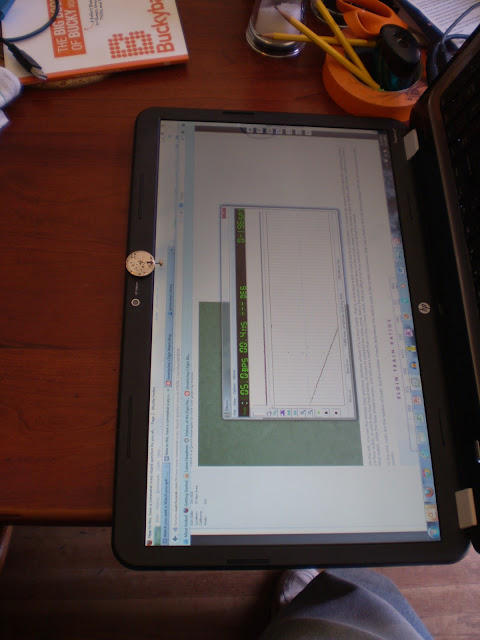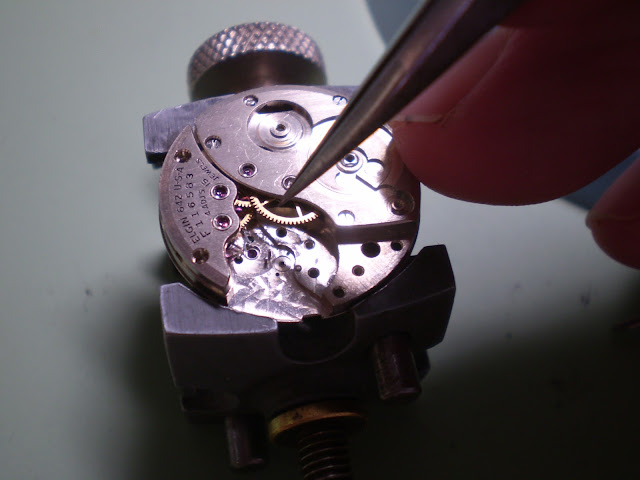At the same time, you can determine amplitude and beat error.
Amplitude is how far the balance swings on each oscillation, and is a good measure of the condition of the watch, how good a job you've done cleaning it, and whether that mainspring really should have been replaced. Ideally, amplitude should be greater than 250 degrees. That is, the balance should swing at least 250 degrees past the point where the roller jewel is in line between the centerlines of the balance and pallet.
Beat error is a measure of how close to perfectly centered the roller jewel is when at rest. Ideally, with no power in the train, the roller jewel should be exactly aligned between the balance and pallet, and should hold the pallet lever exactly midway between the banking pins. This enhances accuracy, and allows the watch to 'self-start' with only a slight winding. In a later post I'll cover how I determine beat error and minimize it.
Although there are a number of timing machines available, if you've been following this blog you know by now that I'm cheap! And in this case I'm also lucky! If you look on watchmaking forums, you'll find a number of posts on using your PC to regulate your watches, and discussions of available software. Invariably one reads about the necessity to obtain a proper piezoelectric microphone, and a preamplifier to boost the signal enough for the PC. In my case, it turns out that the microphone built into the monitor frame of my laptop is perfect for picking up watch ticking!
That's the 642 sitting at the top of the monitor frame, next to the webcam.
I do have to lay it on it's back to do this, but it saves me buying a mic! In this picture, you can also see one of the tools I use, biburo. It used to be available for free download, but now the link is dead.
Sorry!
Biburo claims to be able to detect rate, beat error, and amplitude, though in practice it is best used just for rate. I generally ignore the numbers Biburo gives me in any case, and just go by the trace. In a watch that's running at the correct rate, the trace will be a straight horizonal line. The deviation from horizontal indicates the error. If the line tilts down, the watch is running slow. If up, fast.
Here's the initial trace that this 642 produced:
Slow. REALLY slow. About 3 minutes slow/day. Time to adjust it. I like to use a piece of pegwood to move the regulator. You COULD use tweezers, but they're likely to scratch the balance cock.
Watch the hairspring carefully as you do this. Generally the regulator pins just move along the spring, but sometimes the pins grip the spring too tightly, and it pulls or pushes on the spring itself. You can end up bending the spring if you're not careful! Ask me how I know....
Generally, you don't need to push it very far. Certainly not THIS far! Here's what happened to the rate when I pushed the regulator all the way to the 'Fast' end of the scale:
Now it's too fast! After a few attempts, I got it to this:
Not perfect, but only a few seconds per day of gain. I decided to stop there.
Another important point about the trace is that there's a single line, which indicates low beat error. With significant error, there would be two distinct lines.
Next, to get a more detailed view of how the watch is running, I use eTimer Watch Escapement Analyzer software. There's a freely downloadable software package, in addition to the entire package of the software and the microphone setup. The freeware is limited, and cannot analyze in real time. You need to record the ticking, save it as a .wav file, and analyse the file. This precluded making adjustments on the fly, but it's MUCH cheaper!!
To record the ticking I use Audacity, a free audio editing software package. I record for about a minute, after adjusting the position of the watch for the best pickup. This produces a trace like this:
If you look closely, you'll see a line of regularly-spaced spikes. There should be 5 every second.
I export the trace as a .wav file. Then I open it in eTimer, and allow the software to run. In this case, it's run for 5 minutes, repeating the same 1 minute recording.
eTimer shows two ticks per screen, at the rate they occurred in the recording. There are two ticks for each complete back-and-forth swing of the balance, and if the watch is running reasonably well each new tick will replace an old one, and you won't see the waveform trace wandering too much..
Each tick is composed of 3 components. The first sound is the unlock, when the roller jewel hits the pallet fork, lifting it off the banking pin and unlocking the escape wheel. The last sound is the lock, when the pallet lever hits the other banking pin and the escape wheel locks on the other pallet stone.
The pink strip emulates the paper on a Tick-O-Print, or similar watch timing machine. There's a dot for each tick, and if the ticks occur perfectly at 1/5 second intervals, it will produce a straight line down the page.
The circle with lines emulates the Tick-O-Print cursor disk, and is how eTimer determines the rate, by aligning the cursor with the printed line of ticks. In this case, about +6 seconds per day. Ideally, the line would be straight, rather than wandering. The wander suggests an issue with a part that turns with a period of about a minute, so there may be a small issue with the 4th wheel.
It determines amplitude by measuring the time between the unlock and the lock for each tick. This interval is determined by the angular velocity of the balance as it swings through locking and unlocking. The angular velocity at this point allows the calculation of the amplitude - here about 287 degrees - not bad for a 62 year old, 15 jewel watch!
It determines beat error based on the difference in the interval for alternate ticks - every other tick is a balance swing in the same direction. Here the beat error is about 1.6 milliseconds. Ideally, it would be under 0.5 ms, but that's for another post!
I declare this Good Enough! Watches should be allowed to run for at least a day to settle in, distribute oil, etc. before final timing.
Time to finish putting the watch together. Place the hour wheel over the cannon pinion, and add a dial washer if necessary. Dial washers keep the hour wheel teeth meshed with the minute wheel by gently pushing against the dial. This is not usually a problem with flat dials, but can become severe with curved ones - simply turning the watch dial down may allow the hour wheel to drop out of engagement, and the hour hand will get out of synchronization with the minute hand.
Then drop the dial onto the movement, making sure the dial feet enter the holes. You may need to back the screws out just a bit. When the dial is fully down, tighten the dial foot screws.


Next install the second hand, making sure the pipe goes over the 4th wheel post, and pushing straight down, gently.
Now install the hour hand. It fits onto the tube of the hour wheel. To press it on, I use a flat-faced hollow punch from my staking set, with the hole just large enough to go over the cannon pinion but not the hour wheel tube. This will put the hour hand at the top of the tube, so it doesn't drag on the dial, or catch on the second hand.

Set the hour hand EXACTLY to an hour mark. I prefer to use 3:00 or 9:00, since that gets the hour hand out of the way of the minute hand, and by being at exactly 90 degrees from vertical, is easy to set accurately.
Place the minute hand on the cannon pinion, pointing exactly at 12:00, and press home with the stake. You should feel a slight snap as the hand fits onto the tip of the cannon pinion.

Now you can set the time! Mind you, that will turn out to be a waste....
Why? The next step, at least for this watch, is to remove the stem, and the best way to do this so that you can later re-install it with ease is to pull the crown out to setting position. Then, unscrew the setting lever screw just until the stem comes free.
With the stem removed, carefully lower the movement into place in the case.

This watch has a solid spacer ring, with a tab that fits into a notch on the bezel. You can see them in this picture, at about 2:30, or 45 degrees counterclockwise from the hole for the stem.
Align the ring, and push down till it fits evenly around the movement.

Insert the stem. You may have to wiggle it a bit to align the movement with the ring, and to properly engage the clutch, and get the setting lever engaged in the slot of the stem. Tighten the setting lever screw till it stops, then pull out, push in, and tighten completely - just finger tight.
Now you can replace the back, making sure the threads engage properly before using much force to tighten it down. Ideally, you'd have a gasket in this watch, but I don't have any. Also ideally you'd use the proper wrench to tighten the caseback, but I don't have one of those, either!

And there you have it - a newly cleaned, lubricated, and regulated Elgin Shockmaster watch! Ready for your wrist!
After the watch had been running for several days, I checked the rate again. It was gaining a bit, so I adjusted it slower, using Biburo. For a watch you wear every day, you'd observe how it ran on your wrist - does it gain or lose, and how much? Then you could adjust it on the bench, using the timer, so that it should come out nearly perfect. Although many collectors are satisfied with a watch that runs "plus or minus a few minutes a day", it's worth remembering that these were made to run within a few seconds a day.
All together the whole process from arrival to recasing took about 4-5 hours. A pro could do it faster, and a real novice should take longer. Work at a speed you are comfortable with, and don't forget to take breaks for food and rest. And whatever you do, DON'T try to do this when you're tired, hungry, anxious, or too excited! Rested and relaxed is the key.
By the way, I also cleaned the case and polished the crystal. I'll cover that sometime in the future. Oh, and I added a new, and better-fitting bracelet.






















































